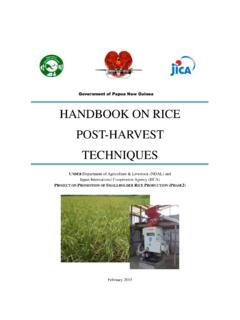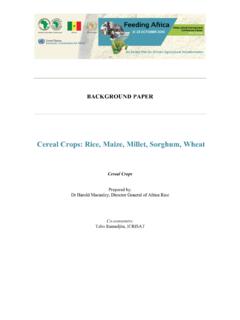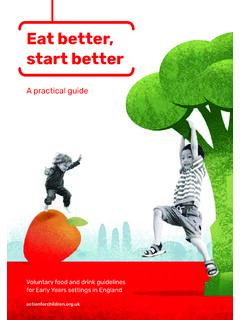Transcription of The Eatwell Guide - GOV.UK
1 Protecting and improving the nation s healthCrispsRaisinsFrozenpeasLentilsSoya drinkCousCouspastaWhole wheatBagelsPorridgeLow fatsoft cheeseTunaPlainnutspeasChickSemimilkskim medChoppedtomatoeslowersaltandsugarBeans WholegraincerealPotatoesSpaghettiLow fatPlainyoghurtLeanminceLower fatspreadSauceOilVegRiceEach serving (150g) containsof an adult s reference intakeTypical values (as sold) per 100g: 697kJ/ 167kcalCheck the label on packaged 34g foods lower in fat, salt and sugarsSource: Public Health England in association with the Welsh Government, Food Standards Scotland and the Food Standards Agency in Northern Ireland Crown copyright 2016 Use the Eatwell Guide to help you get a balance of healthier and more sustainable food.
2 It shows how much of what you eat overall should come from each food Guide2000kcal 2500kcal = ALL FOOD + ALL DRINKSPer dayEat less often andin small amountsChoose lower fat and lower sugar optionsEat more beans and pulses, 2 portions of sustainably sourced fish per week, one of which is oily. Eat lessred and processed meat Potatoes, bread, rice , pasta and other starchy carbohydrates Choose wholegrain or higher fibre versions with less added fat, salt and sugarFruit and vegetables Oil & spreads Eat at least 5 portions of a variety of fruit and vegetables every dayLOWLOWHIGHMEDC hoose unsaturated oils and use in small amountsDairy and alternativesBeans, pulses, fish, eggs, meat and other proteins6-8a dayWater, lower fat milk, sugar-free drinks including tea and coffee all fruit juice and/or smoothies to a total of 150ml a day.
3 Helping you eat a healthy, balanced dietThe Eatwell GuideGet started nowEating well and having a healthy lifestyle can help us feel our best and make a big difference to our long-term health. So why not make a change today? The Eatwell Guide shows the proportions in which different types of foods are needed to have a well-balanced and healthy diet. The proportions shown are representative of your food consumption over the period of a day or even a week, not necessarily each meal Health England in association with the Welsh Government, Food Standards Scotland and the Food Standards Agency in Northern Ireland2Is the Eatwell Guide for me?The Eatwell Guide applies to most people regardless of weight, dietary restrictions/preferences or ethnic , it doesn t apply to children under 2 because they have different nutritional needs.
4 Between the ages of 2 and 5, children should gradually move to eating the same foods as the rest of the family, in the proportions shown on the Eatwell Guide . Anyone with special dietary requirements or medical needs might want to check with a registered dietitian on how to adapt the Eatwell Guide to meet their individual can the Eatwell Guide help?The Eatwell Guide shows the different types of foods and drinks we should consume and in what proportions to have a healthy, balanced Eatwell Guide shows the proportions of the main food groups that form a healthy, balanced diet: Eat at least 5 portions of a variety of fruit and vegetables every day Base meals on potatoes, bread, rice , pasta or other starchy carbohydrates; choosing wholegrain versions where possible Have some dairy or dairy alternatives (such as soya drinks).
5 Choosing lower fat and lower sugar options Eat some beans, pulses, fish, eggs, meat and other proteins (including 2 portions of fish every week, one of which should be oily) Choose unsaturated oils and spreads and eat in small amounts Drink 6-8 cups/glasses of fluid a dayIf consuming foods and drinks high in fat, salt or sugar have these less often and in small should I use the Eatwell Guide ?You can use the Eatwell Guide to help you make healthier choices whenever you re: deciding what to eat at home cooking out shopping for groceries eating out in a restaurant, cafe or canteen choosing food on the go Aim to fill your trolley with a healthy balance of different types of food. 3 How does it work?
6 The Eatwell Guide divides the foods and drinks we consume into five main groups. Try to choose a variety of different foods from each of the groups to help you get the wide range of nutrients your body needs to stay healthy and work properly. It is important to get some fat in the diet, however, foods high in fat, salt and sugar are placed outside of the main image as these types of foods are not essential in the diet and most of us need to cut down on these to achieve our healthy balance. Unsaturated fats from plant sources, for example vegetable oil or olive oil, are healthier types of fat. But remember, all types of fat are high in energy and so should only be eaten in small amounts.
7 Many of the foods we eat, such as pizzas, casseroles, pasta dishes and sandwiches, are combination foods and contain ingredients from more than one of the food groups. For these sorts of food, you just need to work out the main ingredients and think about how these fit with the sections on the Guide . For example, if you re having a cottage pie: the potato fits into the yellow segment; the milk in the mashed potato fits into the blue segment, the spread in the mashed potato fits into the purple segment, the meat, meat substitute or beans would fall into the pink segment; the onion, carrots and peas would fit into the green segment. Let s take a closer look at each of the food closer look at Fruit and vegetablesMost people know we should be eating more fruit and veg, but many of us aren t eating enough.
8 Fruit and veg should make up just over a third of the food we eat each to eat at least five portions of a variety of fruit and veg each day. If you count how many portions you re having, it might help you increase the amount and variety of fruit and veg you eat. Choose from fresh, frozen, canned, dried or juiced. A portion is 80g or any of these: 1 apple, banana, pear, orange or other similar-size fruit, 3 heaped tablespoons of vegetables, a dessert bowl of salad, 30g of dried fruit (which should be kept to mealtimes) or a 150ml glass of fruit juice or smoothie (counts as a maximum of one portion a day).RaisinsChoppedtomatoes4A closer look at Potatoes, bread, rice , pasta and other starchy carbohydratesStarchy food is a really important part of a healthy diet and should make up just over a third of the food we eat.
9 Choose higher-fibre, wholegrain varieties when you can by purchasing wholewheat pasta, brown rice , or simply leaving the skins on your meals around starchy carbohydrate foods. So, you could: start the day with a wholegrain breakfast cereal; choose one lower in salt and sugars have a sandwich for lunch round off the day with potatoes, pasta or rice as a base for your evening mealSome people think starchy food is fattening, but gram for gram it contains less than half the calories of fat. You just need to watch the fats you add when you re cooking and serving this sort of food, because that s what increases the calorie choose wholegrain?Wholegrain food contains more fibre than white or refined starchy food, and often more of other nutrients.
10 We also digest wholegrain food more slowly so it can help us feel full for longer. Wholegrain food includes: wholemeal and wholegrain bread, pitta and chapatti, wholewheat pasta, brown rice , wholegrain breakfast cereals and whole oats. Remember, you can also purchase high fibre white versions of bread and pasta which will help to increase your fibre intake using a like-for-like substitute of your family closer look atDairy and alternativesTry to have some milk and dairy food (or dairy alternatives) such as cheese, yoghurt and fromage are good sources of protein and vitamins, and they re also an important source of calcium, which helps to keep our bones strong. Some dairy food can be high in fat and saturated fat, but there are plenty of lower-fat options to choose from.
















